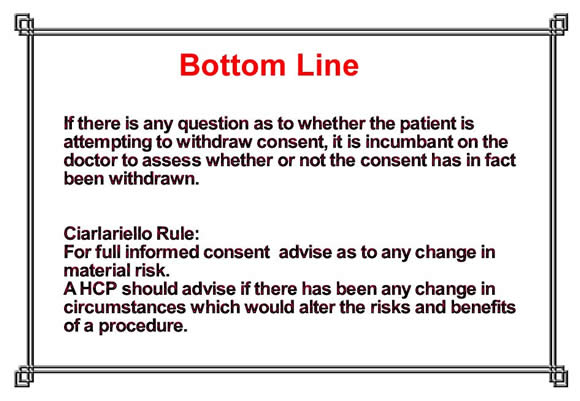Informed Consent
Withdrawing Consent
Ciarlariello v. Schacter, [1993] 2 S.C.R. 119
The patient was diagnosed with a subarachnoid hemorrhage from a cerebral aneurysm. The risk is very high (40 – 50%) of death from further bleeding after an event like this. The patient decided to have surgery to treat the aneurysm. She needed a cerebral angiogram prior to surgery.
The patient's neurologist explained the procedure to the patient who spoke Italian (the patient's daughter acted as a translator). The patient gave her consent to tests and was admitted to hospital and sedated while waiting for the test.
Radiologist (K) who would perform the procedure discussed with patient immediately prior to procedure again why test was necessary, how it would proceed, what the patient would experience during the test and outlined principle risks including risk of death, stroke or paralysis. Radiologist was not convinced that the patient understood the risks, destroyed the informed consent form and sent the patient away. Suggested that family be consulted as not sure that the patient understood the informed consent adequately.
The patient returned later that day with a signed consent form and the angiogram was performed. But a second angiogram was needed and again the patient gave her consent.
Again her consent was obtained and a second radiologist (G) proceeded with the second angiogram.
Some time after the second angiogram began, the patient became very agitated and began shouting and hyperventilating. When she had calmed down, she said "Enough, no more, stop the test." K was present also at this time and concluded that her problems were due to hyperventilation (she had mild weakness of the right hand which was thought to be temporary).
The patient was asked if she wanted to go ahead with the test and the patient said "Please go ahead". K administered the final injection and the patient suffered an immediate "reaction" which resulted in quadraplegia.
The court held that for full informed consent a HCP should advise as to any change of material risks and has to check that the patient is still capable.
The supreme court held that the standard of disclosure was met. The patient was at grave risk for a further stroke with no intervention. A reasonable person in the patients position would have had the intervention.


